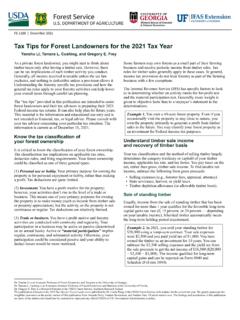Transcription of Biomes: What and Who Lives Where? - University of Georgia
1 Biomes: What and Who Lives Where? Essential Question; What are some animal and plant species that live in each biome? At a Glance: Learners discover facts about different biomes by matching organisms with their biome. Background Information: Biomes are defined as a large geographical area with distinctive plant and animal groups that are adapted to that biome-habitat. Climate and geography determines what type of biome exists in each part of the world. The major biomes include: Rainforest, Tundra, Taiga, Deciduous Temperate forest , Desert, Chaparral, Grassland, Freshwater, and Marine.
2 The plant and animal species that live in each biome have special adaptations that help them survive the conditions of that biome. Many species are endemic to certain biomes, meaning they only exist in that biome and nowhere else. Some species are able to adapt to a wider variety of climatic and geographic influences. Many of the species in the biomes depend upon each other; therefore protection of global biodiversity is very important. The variety of habitats provided by each biome supports the biodiversity of animal and plant species.
3 One biome that is threatened is the Grassland biome. This ecosystem is threatened mainly by urbanization, but also from lack of fire. Fire control has become a problem in many ecosystems, as many plant species require fire to set seed and fire helps to keep other unwanted plant species from taking over. Buffalo have been affected by the loss of the Grassland ecosystem. Though other factors have impacted buffalo populations, conserving habitat is an integral part of protecting biodiversity. Getting Ready: Print cards for the Biome Game in color on cardstock.
4 They will last longer if laminated. Procedure: 1. Pass out a card to each learner. Each card has a biome, animal or plant on it. There are 27 cards total. Have learners pair up, if your club has more than 27 learners. 2. Ask the learners with a card with a biome on it to come to the front of the classroom or outdoor area. The cards with biomes include: Tundra, Taiga, Rainforest, Grasslands, Deciduous Temperate forest , Desert, Chaparral, Freshwater, and Marine Biomes. 3. Have everyone read their card to themselves, silently.
5 4. Have the learners with biome cards read their descriptions aloud for everyone to hear. 5. The learners with animal and plant cards should try to match their species to a biome using the description. They may go to the learner with the biome card and ask to look at it again, if they need help. Location: classroom or outdoors Objectives: Learners will 1) identify Earth's major biomes. 2) name animal and plant species that live in each biome. Skills: communication, matching, teamwork Supplies: Biome cards Animal cards Plant cards World map (optional) Subjects: science Time: 10 minutes 6.
6 Once learners have decided which biome their plant or animal species belongs to, they are to stand behind the person representing that biome. 7. Have each learner read their card aloud and state which biome they think it belongs to. Ask the class if they agree. Discussion/Assessment: What adaptations does each species need to survive in its biome-habitat? What are some other animals that you think may live in each biome? Why is it important to protect biodiversity in each biome? How does the biodiversity and the interdependence of species impact biome/ecosystem health?
7 Rainforest: There are two types of rainforests, Tropical and Temperate, both having high amounts of rainfall. Tropical rainforests have the highest biodiversity in the world. This means that there are many different types of plants and animals in the same area. Tropical rainforests are located around the equator in places such as Brazil and Cameroon. Temperate rainforests have high rainfall like tropical rainforests, but temperate rainforests have cooler temperatures. They are found in the mountains along coasts such as in the Pacific Northwest and areas of the Appalachian forests of the United States.
8 Tundra: The tundra biome is found around the Arctic Circle in the northern hemisphere and on the tops of very high mountains. It is also found in the southern hemisphere in Antarctica. The tundra is the coldest and driest of Earth's biomes. This ecosystem is special because the ground is permanently frozen. This is called permafrost. Plants and microorganisms grow and reproduce during the short summers when the soil thaws for a brief time. The types of plants that can survive here include shrubs, sedges, mosses, lichens, grasses, and some flowering or herbaceous plants.
9 There are only 48 known species of land mammals that live in the tundra biome. Taiga: This biome is made up of coniferous forests and is the largest of all the land biomes. These forests contain evergreen trees that have needles, such as hemlock, firs or spruces. The taiga is located in the northern part of the world throughout Canada, Asia, and parts of Europe. The winters are very cold here. The summers are very sunny, but temperatures rarely climb above 50 F. Desert: The desert biome is extremely dry and extremely hot.
10 Only plants and animals that can adapt to these conditions will survive in this environment. Deserts can be found all over the world - in Asia, Africa, the Middle East and North America. The Chihuahuan and Sonoran Deserts cover parts of the southwestern and Mexico. Temperate Deciduous forest : The southeastern United States is part of the temperate deciduous forest biome. The climate in this area has four distinct seasons. The trees living in this biome are adapted to these changing seasons. In autumn, the leaves of some trees change colors and then fall off.







